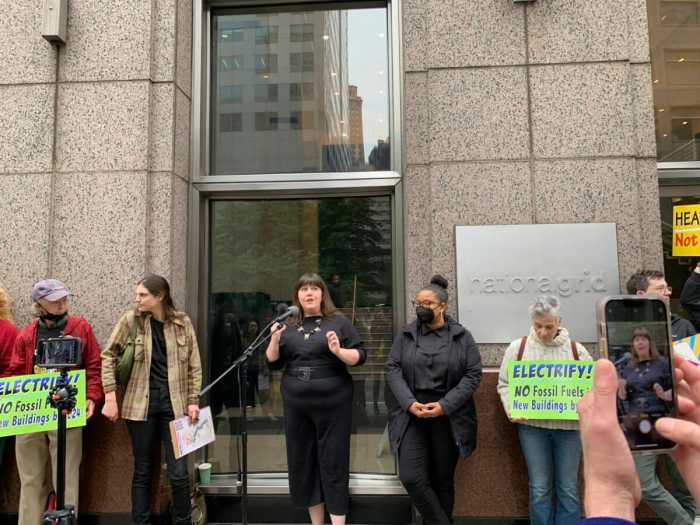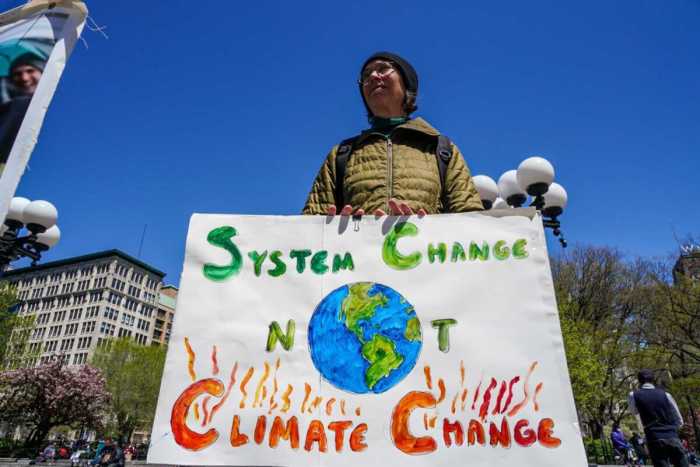Energy business sector officials, along with union, academic and non-profit thought leaders came together Oct. 26 at Molloy University in Rockville Centre to have a conversation on the future of energy for Long Island.
The event was the second of two conferences that Schneps Media organized with sponsorship support from National Grid with the first being held in Downtown Brooklyn. The Long Island event featured 18 thought leaders in the fields of energy efficiency, sustainability, and renewable energy who discussed how they plan to make our energy system more sustainable and environmentally responsible.
Attendees also learned about everything from solar power and electric vehicles to career training and job creation.
“This conversation could not be happening at a better time. As we speak, the New York Climate Action Council is finalizing their Scoping Plan for meeting the clean energy goals laid out in the Climate Leadership and Community Protection Act (CLCPA),” said National Grid New York President Rudy Wynter.
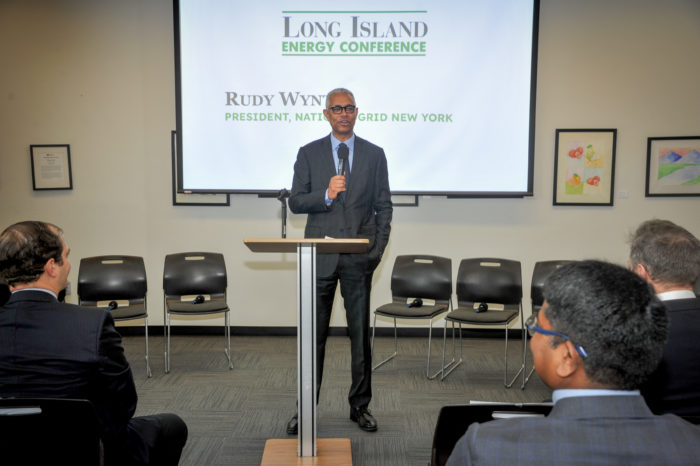
Wynter noted that CLCPA sets some of the most ambitious climate goals in the world, requiring New York to reduce greenhouse gas emissions 40 percent by 2030 and 85 percent by 2050.
“It will be challenging to meet these goals, but we must rise to the challenge. Climate change is an existential threat to us all, and it is critical that we take aggressive action now to meet it head-on. National Grid is committed to working with our partners in Albany, Long Island, and in communities across the state to meet New York’s critical climate change mitigation goals,” Wynter said.
The event was broken up into two panel discussions, with the first focusing on the future of energy on Long Island.
Panelists included Vision Long Island Director Eric Alexander, Northwell Health Chief Sustainability Officer Donna Drummond, Long Island Power Authority CEO Thomas Falcone, Evolve Hydrogen founder and CEO Brian Gilman, Empower Solar co-founder and CEO David Schieren, Nature Energy Vice President of Business Development Chris Voell, Don Chahbazpour, the director, policy and regulatory strategy – Future of Heat for National Grid, and Tristan Brown, associate professor of energy resource economics at the SUNY College of Environmental Science & Forestry.
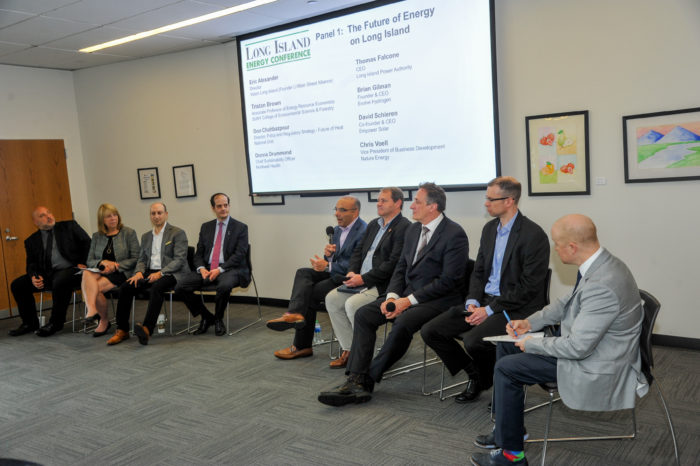
Alexander said both local Long Island businesses and homeowners are facing challenging times when it comes to regulatory changes to both generate green energy and the potential costs involved.
“Folks are coming off a pandemic where for two, three years government regulations have made some people poor, some businesses bankrupt and it’s a challenging time. And you know, there are climate change deniers and that’s not good. There’s also inflation deniers. There’s people out there saying costs aren’t going up. Costs are up and and it’s undeniable, businesses have felt it. And I think residents have felt it. That’s what we hear from the local communities that we work in,” said Alexander.
“So while we all want a clean energy future, we’ve got to do a better job of cleaning the present. We got to do a better job of communicating. Number two, we’ve got to do a better job getting the prices down. And then number three, we’ve got to really work with people where they are at and that means getting more subsidies out there. And there’s a real opportunity on the federal level to do that,” he added.
Chahbazpour said the price of traditional energy has gone up in the last year, but cautioned against the thinking that the rising price for commodities is good for decarbonization.
“Let’s just zoom out of Long Island for a second. We are now living in a global energy crisis and it’s not like the 70s. It’s not an oil crisis. It’s oil, gas, coal, lithium and all the other minerals. Ukraine has made it a lot worse,” said Chahbazpour.
“So what does that mean in Long Island? You know, people are having this debate in Long Island, that if the price of commodities goes up, that’s actually good for decarbonization. Because that means you transition off fossil fuels faster. And the energy industry is actually advocating the opposite. But I think Europe is now sort of exhibit A, where we are actually seeing the impact of high commodity prices and energy prices. Costs are going up and the emissions are going up. Coal was coming back in Europe, unfortunately. But also there is also a lack of investments in renewables, because when the cost of energy goes up, a lot of those are actually feedstocks to make all of the renewable sources that we need. So at least in Long Island, you can put to rest that high energy prices are actually not good for decarbonization,” he said.
The second panel was titled, How do we get there? Challenges and Opportunities.
Panelists included Town of Hempstead representatives, New York League of Conservation Voters President Julie Tighe, The D&F Development Group Principal Peter Florey, Sustainability Institute Molloy University Executive Director Neal Lewis, Association for Neighborhood & Housing Development Executive Director Barika Williams, National Grid Future of Heat Engineering Director Pradeep Kileti, and Pat Guidice, business manager of International Brotherhood of Electrical Workers, Local 1049.
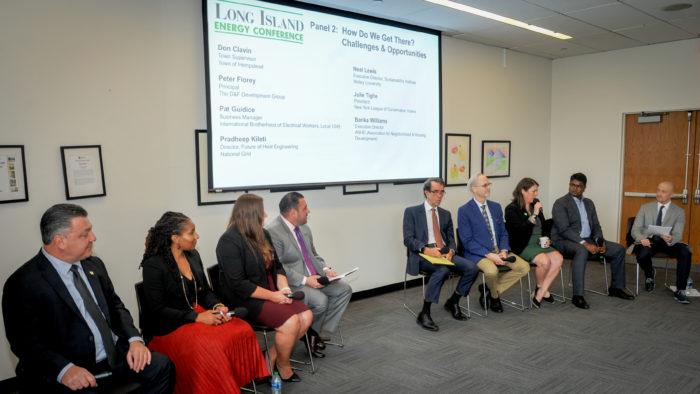
Guidice said Long Island has historically had high energy costs, and that as the Island migrates into a new energy portfolio, there needs to keep a laser-like focus on creating energy delivery and producing energy that is affordable and 100 percent reliable. It also must maintain jobs in the energy sector.
“Electric generation used to create a lot of jobs. Large baseload power plants had to be operated and maintained. Offshore wind will create some skilled, high-paying jobs. I’m hoping hydrogen delivered to energy consumers will provide good paying jobs for the same workers out here that are working in natural gas and at the same time allow for energy consumers to access new technology,” said Patrick Guidice.
Kileti noted that many homes in Long Island are more than 50 or 60 years old.
“We need to make sure we are using energy efficiently and our workforce has evolved. We are moving from centralized to decentralized energy. Solving it together is very important,” said Kileti.
Bryan Grimaldi, National Grid of New York Vice President for Corporate Affairs concluded that it was great for Schneps to put the conference together, to bring in different viewpoints from the Long Island community, and to have an honest conversation on pragmatic solutions that are affordable to customers while trying to solve climate change.
“Affordability is primary, but doesn’t have to be mutually exclusive from pragmatic solutions. National Grid’s fossil-free vision plan meets or exceeds the state’s goals for carbon reduction,” said Grimaldi.
Josh Schneps, CEO Schneps Media, echoed those thoughts. “We were privileged to be able to bring together a diverse group of people playing a critical role in the energy industry to have a conversation about where things are headed, what’s needed and what the opportunities are,” he said.
The Long Island Energy Conference was hosted by Schneps Events, a division of Schneps Media, the parent company of Long Island Press. For more information, visit schnepsmedia.com/events


